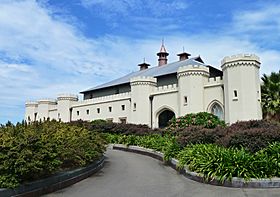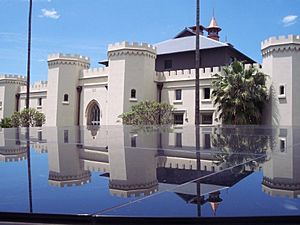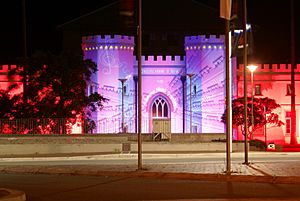Sydney Conservatorium of Music facts for kids

Sydney Conservatorium of Music, as viewed from the Royal Botanic Gardens
|
|
|
Other name
|
The Con |
|---|---|
|
Former name
|
New South Wales State Conservatorium of Music |
| Type | Public university college |
| Established | 1915 |
| Founders |
|
|
Parent institution
|
University of Sydney |
|
Academic affiliation
|
|
| Head of School and Dean | Anna Reid |
| Students | 750 |
| Location |
,
,
Australia
33°51′48″S 151°12′52″E / 33.863455°S 151.214353°E |
 |
|
|
Building details
|
|

The facade of the Greenway-designed building
|
|
| Former names | Stables for the First Government House |
| General information | |
| Status | Complete |
| Architectural style | Gothic Picturesque |
| Construction started | 9 August 1817 |
| Completed | 1820 |
| Client | Colonial Governor |
| Design and construction | |
| Architect |
|
| Renovating team | |
| Architect | Chris Johnson anor |
| Renovating firm | NSW Government Architect with Daryl Jackson, Robin Dyke and Robert Tanner |
| Official name | Conservatorium of Music; Government House Stables; Governor's Stables |
| Type | State heritage (built) |
| Criteria | a., b., c., d., e., f., g. |
| Designated | 14 January 2011 |
| Reference no. | 1849 |
| Type | Stables |
| Category | Government and Administration |
The Sydney Conservatorium of Music (formerly the New South Wales State Conservatorium of Music and known by the moniker "The Con") is a heritage-listed music school in Macquarie Street, Sydney, New South Wales, Australia. It is one of the oldest and most prestigious music schools in Australia. Located adjacent to the Royal Botanic Gardens on the eastern fringe of the Sydney central business district, the conservatorium is a faculty of the University of Sydney, and incorporates the community-based Conservatorium Open Academy and the Conservatorium High School. In addition to its secondary, undergraduate, post-graduate and community education teaching and learning functions, the conservatorium undertakes research in various fields of music. The building was added to the New South Wales State Heritage Register on 14 January 2011.
Contents
The Greenway building
Originally commissioned in 1815 as the stables for the proposed Government House, the oldest Conservatorium building was designed by the convict architect, Francis Greenway. Listed on the State Heritage Register in the Gothic Picturesque architectural style with turrets, the building was described as a "palace for horses" and is a portrayal of the romantic vision of Governor Lachlan Macquarie and the British architectural trends of the time. It is the only example of a gothic building designed by Greenway still standing. The cost and apparent extravagance was one of the reasons Macquarie was recalled to Britain. The stables, located close to picturesque Sydney Harbour, reflect the building techniques and the range of materials and skills employed during the early settlement era.
Origins of the Conservatorium
In 1915 the NSW Government under William Holman allocated £22,000 to the redevelopment of the stables into a music school. The NSW State Conservatorium of Music opened on 6 March 1916 under the directorship of the Belgian conductor and violinist Henri Verbrugghen, who was the only salaried staff member.
Verbrugghen's impact was incisive but briefer than had been hoped. When he put a request to the NSW Government that he be paid separate salaries for his artistic work as conductor of the orchestra (by then the NSW State Orchestra) and educational work as Director of the Conservatorium, the Government withdrew its subsidies for both the orchestra and the string quartet that Verbrugghen had installed. He resigned in 1921 after taking the Conservatorium Orchestra to Melbourne and to New Zealand.
The Conservatorium was home to Australia's first full-time orchestra, composed of both professional musicians and Conservatorium students. The orchestra remained Sydney's main orchestra for much of the 1920s, accompanying many artists brought to Australia by producer J. C. Williamson, including the legendary violinist Jascha Heifetz, who donated money to the Conservatorium library for orchestral parts. However, during the later part of the stewardship of Verbrugghen's successor, Dr W. Arundel Orchard (Director 1923–34), there were tensions with another emerging professional body, the "ABC Symphony Orchestra", later to become the Sydney Symphony Orchestra, driven by the young, ambitious and energetic Bernard Heinze, Director-General of Music for the Federal Government's new Australian Broadcasting Commission.
In 1935, under Edgar Bainton (Director 1934–48), the Conservatorium Opera School was founded, later performing works such as Verdi's Falstaff and Otello, Wagner's Die Meistersinger von Nürnberg and Die Walküre, and Debussy's Pelléas et Mélisande, among others. Under Sir Eugene Goossens (Director 1948–55), opera at the Conservatorium made a major contribution to what researcher Roger Covell has described as " the most seminal years in the history of locally produced opera...". Although the most prominent musician to have held the post of Director, Goossens' tenure was not without controversy. Apart from the international scandal surrounding his departure in 1956, Goossens was said during his directorship to have channelled the best players in the Conservatorium Orchestra into the Sydney Symphony Orchestra (of which he was concurrently Chief Conductor),
Expansion and reforms
Under the direction of Rex Hobcroft (1972–82), the Conservatorium adopted the modern educational profile recognised today. Hobcroft’s vision of a "Music University" was realised, in which specialised musical disciplines including both classical and jazz performance, music education, composition and musicology enriched each other.
In 1990, as part of the Dawkins Reforms, the Conservatorium amalgamated with the University of Sydney, and was renamed the Sydney Conservatorium of Music.
A 1994 review of the Sydney Conservatorium by the University of Sydney resulted in a recommendation that "negotiations with the NSW State Government about permanent suitable accommodation for the Conservatorium be pursued as a matter of urgency."
As in 1916, a wide range of sites were considered, many of them controversial. In May 1997, 180 years after Governor Macquarie laid the foundation stone for the Greenway Building, State Premier Bob Carr announced a major upgrade of the Conservatorium, with the ultimate goal of creating a music education facility equal to or better than anything in the world. A team was assembled to work to that brief, resulting in a complex collaboration between various government departments (notably the Department of Education and Training and the Department of Public Works and Services), the Government Architect, US-based acoustic consultants Kirkegaard Associates, Daryl Jackson Robin Dyke Architects, the key users represented by the Principal and Dean of the Sydney Conservatorium of Music, and the Principal of the Conservatorium High School, the Royal Botanic Gardens and Domain Trust and many others.
Centenary commissions
To mark the centenary of the Conservatorium in 2015, it commissioned 101 new works, the spread designed to represent those who have shaped music over the past 100 years. The first work in the series was John Corigliano's Mr Tambourine Man, based on the poetry of Bob Dylan, which was presented on 11 September 2009.
Notable teachers
- Winifred Burston, piano
- Edwin Carr, composition
- George De Cairos Rego (1858-1946) piano
- Richard Goldner, viola
- Isador Goodman, piano
- Alex Henery, double bass
- Stephanie McCallum, piano
- William Motzing, jazz
- Robert Pikler, violin and viola
- Goetz Richter, violin, Associate Professor and Chair of Strings
- Nancy Salas, piano and harpsichord
- Natalia Sheludiakova, piano
- Lois Simpson, cello
- Howie Smith, jazz
- Alexa Still, flute
- Alexander Sverjensky, piano
- Ernest Truman
- Mark Walton, woodwind, performance
- Gordon Watson, piano
- Fred Werner (active 1909-1915)
- Wanda Wiłkomirska, violin
- Gerard Willems, piano
Notable teachers
- Winifred Burston, piano
- Edwin Carr, composition
- Richard Goldner, viola
- Isador Goodman, piano
- Alex Henery, double bass
- Stephanie McCallum, piano
- William Motzing, jazz
- Robert Pikler, violin and viola
- Natalia Sheludiakova, piano
- Lois Simpson, cello
- Howie Smith, jazz
- Alexa Still, flute
- Alexander Sverjensky, piano
- Mark Walton, woodwind, performance
- Gordon Watson, piano
- Wanda Wiłkomirska, violin
- Gerard Willems, piano
Images for kids
See also
 In Spanish: Conservatorio de Música de Sídney para niños
In Spanish: Conservatorio de Música de Sídney para niños





